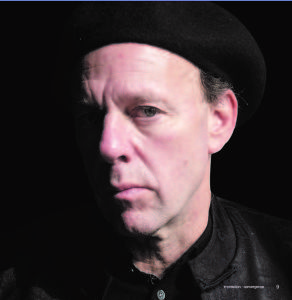
生平簡歷
在七十年代初期,Weinberg在Alfred學習陶瓷藝術,但是他很快轉換到了玻璃藝術,師從玻璃工作室藝術家先鋒Andre Billeci和從英國的皇家藝術學院畢業的蘇格蘭藝術家Eric Hilton。Hiton作為Weinberg的一位非常重要的導師,他鼓勵Weinberg開拓新的技術,進行更為自由的玻璃吹制創作;同時,在這位導師的幫助下,Weinberg也開始學習和掌握玻璃的切割打磨技術。
此後,Weinberg又選擇在羅德島設計學院繼續他的研究生生涯。在那裡,他和Dale Chihuly一起工作。當時Dale Chihuly作為該學院的院長, Weinberg得到了他的教導,並開始成為一名職業藝術家。
1979年Weinberg正式畢業,並開始籌建自己的工作室,獨立設計和打造工作室的所有設備,這在七十年代的美國是一種非常前衛的做法;如今,這種自有的玻璃工作室已在美國非常普遍。
近30年來,Weinberg一直從事玻璃藝術創作,並以此做為自己的事業,成為一名自由藝術家。他一直在羅德島的工作室中,不斷創作和創新,在這裡誕生了眾多不同系列的作品;同時,他也被邀請成為很多國際公司的設計師,為不同品牌提供設計。同時,Weinberg也非常關注中國,並堅信玻璃藝術未來的春天將在中國;他曾不僅一次來到中國,講授玻璃藝術,同時也尋求在中國舉辦他的個人展覽,讓更多的人了解和喜歡玻璃藝術。從2013年起,他將在杭州中國美術學院擔任研究生導師,為中國的玻璃藝術教育盡一份心力。
獲獎情況
2008年,美國康寧玻璃博物館,玻璃工作室大師稱號2002年,美國使館藝術項目負責人
1985年,日本北海道立近代美術館舉辦“World Glass NowExhibition”展覽,榮譽獎項
1984年,獲美國國家藝術基金會獎助金
1980年,獲美國國家藝術基金會獎助金
1978年,獲美國“Young Americans:Clay/Glass”金獎
個展精選
2008年,“Liuli Singapore”,百麗宮,新加坡2007年,“Liuli China”,中國上海
2006年,里奧開普蘭現代藝廊,美國紐約
2006年,Marx-Saunder's畫廊,美國芝加哥
2006年,Dane畫廊,美國南塔科特
2004年,里奧開普蘭現代藝廊,美國紐約
2004年,Davis & Cline 525畫廊,美國阿什蘭
2004年,Habatat玻璃藝術館,美國佛羅里達
2003年,Marx-Saunder's畫廊,美國芝加哥
2003年,Hawk畫廊,美國哥倫比亞
2002年,Habatat玻璃藝術館,美國伯明罕
2002年,里奧開普蘭現代藝廊,美國紐約
2002年,Flinn畫廊,格林威治圖書館,美國
2002年,Etienne- Van den Doel畫廊,荷蘭海牙
2001年,里奧開普蘭現代藝廊,美國紐約
2001年,Janice Charach Epstein 藝術館,美國邁阿密
2000年,Marx-Saunder's畫廊,美國芝加哥
2000年,William Traver畫廊,美國西雅圖
1999年,Coplan畫廊,美國佛羅里達
1999年,畫廊 Rob Van Den Doel,荷蘭海牙
1999年,Habatat玻璃藝術館,法明頓希爾斯,美國邁阿密
1998年,Riley Hawk畫廊,美國克里夫蘭
1998年,Highline畫廊,美國阿斯彭
1998年,Chappell畫廊,美國波士頓
1997年,Habatat玻璃藝術館,美國科羅拉多
1996年,Marx-Saunder's畫廊,美國芝加哥
1995年,Grand Central畫廊,美國佛羅里達
1995年,Kristina Wasserman畫廊,美國羅德島
1993年,Habatat玻璃藝術館,法明頓希爾斯,美國邁阿密
1992年,Heller畫廊,美國紐約
1992年,Bently-Tomlinson畫廊,美國斯克茲代爾
1992年,Helander畫廊,美國邁阿密
1991年,Sandra Ainsley畫廊,加拿大多倫多
1991年,Brendan-Walter畫廊,美國加利福尼亞
1991年,Habatat玻璃藝術館,美國佛羅里達
1990年,Pascal Vandewalle畫廊,比利時安特衛普
1990年,Heller畫廊,美國紐約
1990年,Sanske畫廊,瑞士蘇黎世
1990年,布卡拉頓Habatat畫廊,美國佛羅里達
1990年,Habatat玻璃藝術館,美國佛羅里達
1990年,Kavesh畫廊,美國愛達荷
1990年,Betsy Rosenfield畫廊,美國芝加哥
1989年,Habatat玻璃藝術館,美國佛羅里達
1988年,Habatat玻璃藝術館,美國佛羅里達
1988年,Habatat玻璃藝術館,美國邁阿密
1988年,Heller畫廊,美國紐約
1988年,Sanske畫廊,瑞士蘇黎世
1986年,Klein畫廊,美國芝加哥
1986年,Holsten畫廊,美國佛羅里達
1986年,Elaine Potter畫廊,美國舊金山
作品收藏
康寧玻璃博物館,美國紐約大都會博物館,美國紐約
京都國立近代美術館,日本
維克多利亞和阿爾伯特博物館,英國倫敦
羅浮宮裝飾藝術博物館,法國巴黎
紐約美國工藝博物館,美國
北卡羅來納州阿須維爾藝術博物館,美國
克萊斯勒汽車博物館,美國諾福克
克利夫蘭藝術博物館,美國俄亥俄
辛辛那提藝術博物館,美國俄亥俄
哥倫布藝術博物館,美國俄亥俄
底特律藝術學院,美國
華盛頓大學華盛頓藝術博物館,美國華盛頓
北卡羅來納州胡桃木藝術博物館,美國
亞特蘭大高等藝術博物館,美國
北海島立近代藝術博物館,日本
亨廷頓藝術博物館,美國
印第安納波利斯藝術博物館,美國
伊利諾斯大學納特美術館,美國
沃索Leigh Yawkey Woodson藝術博物館,美國
洛杉磯藝術博物館,美國
邁阿密大學洛爾藝術博物館,美國
威斯康辛州Milwaukee藝術博物館,美國
夏洛特敏特藝術博物館,美國
蒙特婁藝術博物館,加拿大
裝飾藝術博物館,瑞士洛桑
蒙特婁藝術博物館,加拿大魁北克
Sars-Poteries玻璃博物館,法國
藝術與設計博物館,美國紐約
波士頓美術博物館,美國
藝術皇宮博物館,德國杜塞道夫
紐奧良藝術博物館,美國
北卡羅萊羅大學,美國
諾頓美術館,美國佛羅里達
PatrickLannon基金會,美國佛羅里達
美國藝術博物館林威克畫廊,美國
羅德島學院設計藝術博物館,美國
西雅圖美術館,美國
華盛頓Smithsonian學院,美國
夏威夷檀香山文化藝術基金會,美國
聖路易斯藝術館,美國
托萊多藝術博物館,美國俄亥俄
偉茲沃爾斯博物館,美國康乃狄克
拉辛Wustum藝術博物館,美國
手工藝博物館,美國紐約
藝術家點評
玻璃,一種能夠呈現透明質感的非晶形固體。玻璃之所以會成為最具吸引力、最不同尋常的材質,或許要歸功於其通透的特性。這也是促使StevenWeinberg去選擇玻璃、而非其它媒介來進行藝術創作的原因。光線在玻璃內部會呈現各異的形態,這一獨特性質是其他媒介所不具備的。正因為如此,Weinberg才會利用玻璃來呈現作品的空間感與形態。長期以來,Steven Weinberg都被公認為玻璃鑄造藝術領域的大師級人物,但令他的作品真正大放異彩的卻是他那嫻熟的切、磨、拋光以及機具加工技藝。憑藉這些潤飾技巧,創作於玻璃內空間中相互交織的細節才會如此光彩熠熠。玻璃與眾不同的性質是藝術家創作每一件作品的靈感來源,35年來如一日。Steven Weinberg將玻璃的藝術潛力發揮得淋漓盡致。
Weinberg的藝術創作始於20世紀70年代中期。當時的人們對於鑄造玻璃還所知甚少。Weinberg的同行以及各大工藝院校幾乎將所有的精力都投入了吹制玻璃領域。那時的藝術家都不約而同地強調形式上的自由以及對色彩的大膽嘗試。Weinberg則是最早一批放下吹管、專注於鑄造玻璃創作的藝術家。由於沒有現成的參考資料作為指導,藝術家發展出了自己的slump casting技法,並不斷加以提煉。時至今日,其中很多技法仍為世界各地的院校所採用。在Weinberg看來,創作概念永遠先於製作工序;每當他希望通過玻璃媒介呈現出某種新的概念時,就會發明出不同以往的製作手法。
Weinberg的工作方式好像鍊金術師,用他能想到的一切辦法對玻璃進行實驗和加工。他用貴金屬與玻璃相混合,扭轉其形態,保留、甚至向內空間注入氣泡,把玻璃切割、鑄造成各種形態。Weinberg善於利用玻璃對光線的反射和折射性質,以及這種材質的通透性。他的作品從來都不是材質與色彩的簡單堆砌。
即便是很多與他同時代的玻璃藝術家,也會忽視這種材質非同尋常的通透性與清澈度。但Weinberg從來都不會。對於每件作品,他都要完全掌握每一道工序所呈現的特性。他所鑄造的藝術品中看不到兩種形態混合在一起;看不到對材質的模糊處理。所有物件都是那么清透、獨立的個體。他的每一步處理都經過了周密的考慮。即便出錯,即便作品被拒絕,也無所謂;探索和塑造這種令人驚嘆的材質才是藝術家真正享受的事情。年復一年,他對玻璃的這種鍾愛從未改變。
玻璃絕非平凡無奇的材質。儘管藝術家多年從事玻璃藝術的創造,但他仍在不斷探索,嘗試更多玻璃鑄造的技法。他不允許自己停滯不前,而是要不斷將玻璃創作技藝推向新的方向,以新的手法表現自己的作品。
Sharon Oleksiak
2011年3月27日
作品系列介紹
格線1976-1979 這是藝術家首度創作的系列作品。這些鑄造玻璃藝術品最開始是對格線和重複結構的研究,採用一種建築用塊狀玻璃Vista Brick為製作材料。與藝術家在後續作品中使用的水晶玻璃不同,這種綠色的建築用玻璃不具備水晶玻璃的光學性質,而是呈現出平面感、小巧的塊狀結構,同時體現出Weinberg在早期試圖掌控作品形狀的努力。GRIDS1976 -1979 This is the first series of workcreated by the artist.Beginning asstudies about grids and repetition, these castings were made with architecturalconstruction block, Vista Brick, a green glass without the optical qualities ofthe crystal used in subsequent work. This construction glass contributed to thesense of the flat, minimal look of the pieces and represents Weinberg’s earlyefforts to exercise control in his forms.拼圖1979 -1982
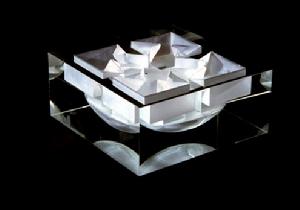
“拼圖”是最初已定性的“格線”的延伸,標誌著從二維到三維格線的轉變。此時Weinberg開始在鑄造藝術品中使用光學水晶玻璃,這種材料的特性能夠創造出第四維的觀感。
PUZZEL VESSELS1979 -1982
An extension of the initial, defining Grids, the Puzzle Vessels signaled thetransition from a two-dimensional to a three dimensional grid. Weinberg beganusing optical crystal in these castings and, with the qualities of thismaterial, created a sense of a 4 dimension.
零件1982 -1984
這幾件作品依然是對光學拼圖所具有的三維格線的探索。如果說“拼圖”是對格線內部的挖掘,那么“零件”則是格線的外化。COMPONENT STRUCTURES1982 -1984These pieces were a continued exploration of the 3dimensional grid of the Optical puzzles. While the Optical puzzles werecreations of an interior grid, with the Component Vessels, the grid becomesexternal.
豎桿與平板
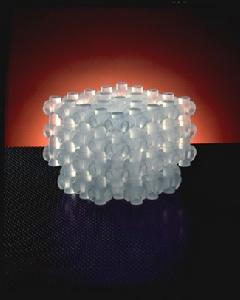
1984-1989
從建立格線發展到探索平衡。這個系列標誌著藝術家對建築元素的運用:立柱與門楣,豎桿與平板。藝術家不斷探索規模與空間的組合,同時力圖保持視覺與實際結構的平衡。
POST AND SLAB
1984-1989
Moving away from the grid and into an exploration ofbalance. This series marks the beginning of using architectural references; thecolumn and lintel, the post and slab. The addition andsubtraction of mass and void was explored while striving to maintain bothvisual and actual balance.

非對稱
1985-1987
這些作品意在質疑“豎桿與平板”系列作品所呈現的平衡感。它們看起來搖搖欲墜,幾近坍塌,對之前作品所呈現的那種垂直關係提出挑戰。這一系列就是要給人以不穩固之感,但實際上卻實現了完美的平衡和穩固。
ASSYMETRIC
1985-1987
These piecesmean to question the sense of balance with the Post and Slab pieces. They seemto be visually precarious and have a sense of falling, and they challenge theperpendicular relationships of the earlier pieces. They are meant to feelunstable, but in reality are perfectly balanced and not all precarious.
立方體
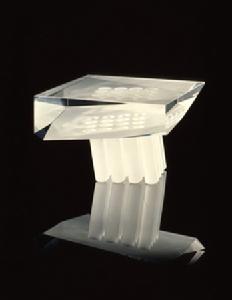
1987-1997
CUBES
1987-1997
透明立方體
從20世紀90年代開始,Weinberg開始痴迷於立方體結構。這種純粹的幾何形式包含了豐富的內部語言。在長達十年的時間裡,這種變化始終都是內在的、而非外生。在最初,藝術家對作品內部結構的處理受到了墨西哥尤卡坦半島和瑪雅文明遺址建築的影響。一開始Weinberg採用透明的光學水晶玻璃創作這個系列,以探索這些建築形式。作品的內部構造隨著內部薄紗狀遊絲和氣泡的產生而充滿靈動,令人驚嘆。隨之,氣泡也成為了Weinberg作品的一大標誌。自該系列之後,藝術家開始利用水晶玻璃的固有品質不斷試驗,將其特性發揮到了極致。
Clear Cubes
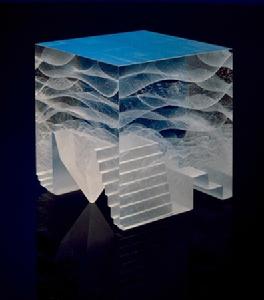
In the early 1990s, Weinberg begins his obsessionwith the cube. A pure geometric form that houses an interior vocabulary thatchanges within, but not from without for the next 10 years. The interiors beginwith the Architectural influences from the YucatanPeninsula in Mexico andMayan ruins. Weinberg begins this series with clear optical crystal to explorethese architectural forms. Fantastic interiors evolve with movement created by gossamer veils and the introduction of inner air bubblesthat become a signature of his work. With this series, the artist begins totake advantage of the substantive qualities of crystaland experiment and push the limits of the material.
彩色立方體
在Weinberg的所有作品中,他都會從簡單的鑄造手法開始,再不斷推進,逐漸提高作品在內部語言和外在形式上的複雜程度。藝術家之所以把色彩引入立方體系列,實際上是將之作為加強對比的一種手段,而非對彩色玻璃本身的探究。立方體因而變得更大,內部的建築元素也日趨複雜。正是在這些作品上,Weinberg作品中流露出了希臘羅馬式建築語言的最初跡象。
Cubes with Color
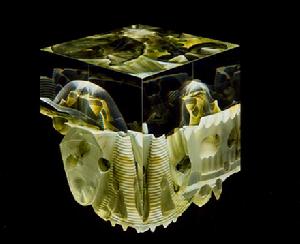
As in all Weinberg’s work, the artist begins a serieswith simple castings and pushes the work to become more and more intricate inboth internal vocabulary and external form.
The artist introduces color to his cubes as a means toadd contrast, and not as an exploration of colored glass.The cubes become larger and the interiorarchitectural elements more complex.Itis here that we see the first signs of a Greco-Roman architectural vocabularyin his work.
金字塔/四面體/球體
1996-1997
這一系列是藝術家從幾何立方體的首次偏離。經過歷時10年之久的單一幾何創作,儘管藝術家依然會創作一些立方體作品,但也開始努力嘗試其它一些歐幾里德式的幾何形體,向立方體告別。
PYRAMIDS/TETRAHEDRONS/SPHERES 1996-1997
This series is the first divergence from the geometryof the cube.After 10 years of workingwith a single geometry, and although he still creates some cubes, the artiststrives to work with other Euclidian forms and movesaway from the cube.
圖示1997-1999
這些作品標誌著藝術家的創作方向發生了明顯轉變。這是藝術家第一次主動建立一套原則來約束自己的創作。這些參考原則中最重要的一條就是:所有的視覺表現,無論以圖示還是符號的形式呈現,都必須是遺失物(foundobjects),而不能出自藝術家之手;既可以是人造物,也可以從自然界中尋得。
這一系列又分為四組:靜物;肖像與自畫像;故事;以及完美。最後一組是將人類對於完美的感知與自然界所發現的真實的完美進行對比。
ICONS1997-1999
These pieces reflect a marked change in direction forthe artist.This is the first time theartist self imposes specific guidelines within which to work.The most important of these guidelines beingthat all the visual imagery, in the form of icons or symbols, needed to befound objects and not manufactured by the artist himself. They could be eithermanmade or found within nature.
There are four subtexts within the series:The Still Life, the Portrait and the SelfPortrait, the Story, and Perfection, comparing man’s perception of perfectionwith the actual perfection found in nature.
船1999-2006
BOAT FORMS
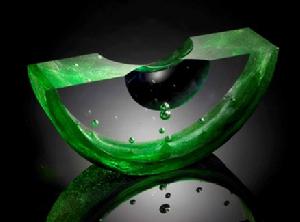
1999-2006
小船1999-2006
在藝術家創作生涯的這一時間段,他遷居海濱,周邊環境對其產生了深遠的影響。他深深地愛上了海釣和大海,船隻與浮標形狀的物體時刻圍繞在他身邊。結果,捕魚船船身的橫截面激發了藝術家的靈感,成為他重點創作的新形式。
Smallboat forms1999-2006
Atthis time in his life, the artist relocates to live by the water and isprofoundly affected by his environment. Boats and buoy forms surround him as hepursues avidly his love of fishing and the sea. As a result, he is inspired bythe cross section of the hull of the fishing vessel and it becomes the nextform to be his focus.
大船2003-2006
這一系列的作品是小船形狀的一種延伸,表明藝術家渴望完整探索作品的軀體,將創作材料和技巧發揮至極限。體型的增大為藝術家的創作表達提供了更大的面積,造成了更為強烈的視覺衝擊。
LargeBoat forms2003-2006
Anextension of the small boat forms, this series of pieces exemplifies theartist’s need to completely explore a body of work, and push the technicallimitations of the material and his techniques. The increased scale provides a larger surface for the artist to expresshimself with greater visual impact.
浮標
1999-2005
“‘浮標’最初是我對泡沫塑膠標記的一種闡釋。漁民用這種標記指示航線線路、漁網或者羅網的位置。浮標隨著大海澎湃的波浪起伏,辛勤的漁民在浮標上潦草地寫下各種名稱和標識。浮標這種物體是大自然與人類歷史的雙重饋贈。它們成為了一種參照物,是被包含在內的宇宙。通過鑄造玻璃的詮釋,浮標承擔起了象徵性標記的責任,為迷路的人指示方向,總能把我們精確地帶回到你離開它時的位置。至少浮標賦予了我們信念,那就是我們一定能回到某個曾經造訪的地方。在如此浩瀚的大海上,能夠重新回到某個精確的位置確實令人驚嘆不已,畢竟人類目力所及的參照物少之又少。”
Glass Magazine雜誌,GeoffWichert
BUOYS
1999-2005
“The ‘Buoy’ started as myinterpretation of Styrofoam markers that are used byworking fishermen to signal route, net or trap. Shaped by the power of anunforgiving sea, juxtaposed with names and identifiers scrawled by industriousworking hands. The floats are objects, which describe a legacy of both natureand personal history. The buoys become both a referential object and acontained universe. Interpreted in cast glass, they take on the mantle ofsymbolic markers, accessible to all who search, always bringing us back to theexact location we left them. Or at least giving usfaith that we can return to a place that we once had visited. It truly isamazing to be able to revisit a precise spot in an ocean so vast with fewvisual references for guidance. ”
Glass Magazine,Geoff Wichert
水晶陶瓷
2005-2006
Weinberg曾在創作浮標時使用過金屬噴塗技術。而在這件小巧的作品中,他通過再次使用這一技術,嘗試著重溫他最初從事的陶瓷製造。這件作品的重點在於採用這種中空的經典陶瓷造型,將之轉變為結實的固體,並且在外觀上賦予其金屬的質感,以表達對赤色陶瓦藝術的一種懷念。這一作品實現了質量與外觀的融合。
CRYSTAL CERAMICS 2005-2006
Experimenting toget back to his ceramic roots through the use of the spray metalizing techniqueused with the buoys, Weinberg creates this small body of work. The idea oftaking hollow, classic ceramic forms, translating them into massive solids andfinishing the exterior with a skin of metal treated to appear reminiscent ofterracotta is central to this this work. The mass has become the skin and theskin has become the mass.
等壓線
2004-2005
這件作品和那些大船一樣,都表現出藝術家不斷將技巧推至極限。在這裡,他將大船系列作品的形狀變成了渾圓的,專注於掌控薄紗狀遊絲物的形態。
ISOBARS
2004-2005
This work, likethe large boats is another example of the artist pushing technique. Here, hechanges the form of the boat series toward the round and focuses on controllingthe gossamer veil.
曼陀拉
2005-2010
2005年,Weinberg受邀到中國北京的清華大學授課。他的摯友及同事Rudy Nakai曾說:“一旦你下了飛機,雙腳踏上中國的土地,你的人生將就此改變。”的確,藝術家的作品中,第一次呈現出了中國對他的深遠影響。
MANDALAS
2005-2010
In 2005, theArtist is invited to teach at TsinghuaUniversity in Beijing. As is stated by his dear friend andcolleague, Rudy Nakai:“Once you stepoff the plane in The People’s Republic of China, your life will never be thesame.” For the first time in the artist’s work, there appears the profoundinfluence of China.
圓形曼陀拉CIRCULARMANDALAS
方形曼陀拉SQUAREMANDALAS
人體
1979-至今
這一類別的作品從藝術家創作生涯的初始階段就從未間斷過。Weinberg著迷於女性形象。長年以來,他一直在創作這類玻璃藝術品,但卻從未想過要將它們示人,而只是為了享受創作的愉悅。他的第一件人體藝術品取材自其工作室周邊街道上遊蕩的妓女。後來,當地一家畫廊鼓勵Weinberg展出這些作品。於是,藝術家又創作出了更多人體形象。為了讓作品達到完美,他努力地用自己特有的方式重現人體皮膚上的每個細節與標記。這些作品的非凡之處不僅在於它們都是真人大小,更在於對細節不遺餘力的闡釋,以及藝術家重現女性體態和皮膚上所有或醜陋、或美麗的細節的能力。
BODY CASTS
1979-present
This body of workhas been ongoing from the inception of the artist’s career. Weinberg has alwayshad a fascination with the femaleform and over the years created these castings, never with the expectationto exhibit, but simply for the enjoyment of creation. The first body casts were done using thestreet walking population embedded in the neighborhood close to thestudio.Later, with the encouragement ofa local gallery to use them in an exhibition, he created more and strove torecreate every detail and marking on the skin in his typical manner to perfecthis castings.These pieces areextraordinary not only in their true to life size, but in their intricatedepiction of detail and the artist’s ability to recreate every blemish andbeautiful marking of female form and surface of the skin.
玻璃棒素描
2010-至今
這是藝術家目前正在從事創作的系列。在這裡,他仍舊在曼荼羅系列的框架內進行創作,但注意力都集中在素描上。通過玻璃吹制者使用的傳統玻璃棒製作技巧,藝術家開始在作品中定義他的個人語言。這些三維素描專注於素描的幾個基本元素:點、線、面,以及交叉。
CANE DRAWINGS
2010-present
This is theartist’s current body of work. Here, he works within the framework of theMandala series, but focuses on drawing. Taking traditional cane makingtechniques used by glass blowers, the artist begins to define an individuallanguage in his castings.These threedimensional drawings focus on the basic elements of drawing: Point, line, plane, and intersection.
